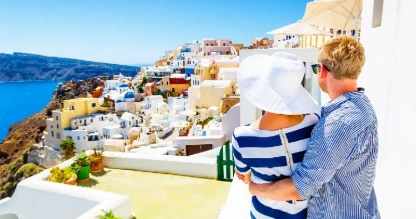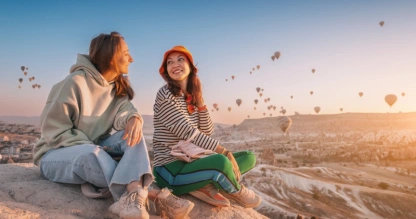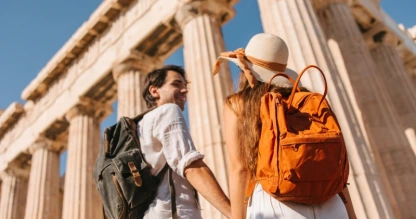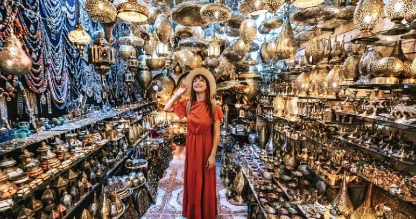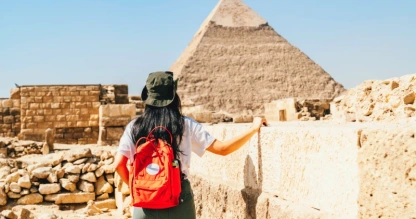
Inside the Blue Mosque of Istanbul
The Blue Mosque stands as Turkey's most magnificent architectural treasure in Istanbul. Its breathtaking interior contains over 20,000 hand-painted blue Iznik tiles. This remarkable structure, built between 1609 and 1616, rises majestically with six towering minarets.
The mosque's official name is the Sultan Ahmed Mosque, and its breathtaking central dome has a diameter of 77 feet (23.5 m) while reaching 141 feet (43 m) into the sky. The building's location holds historical importance, being wedged between historic Hagia Sophia and the Byzantine Hippodrome.
The past of the mosque is filled with sorrow - its completion in 1617 was followed by the subsequent death of its supporter Sultan Ahmet I in his 27th year. The architectural masterpiece is frequented by scores of Muslims who worship there five times a day, and attracts visitors worldwide who come to marvel at its beauty.
What to consider before going to the Blue Mosque
A smooth and respectful visit to the Sultan Ahmed Mosque needs some preparation. The right information regarding visit rules, dress code, and entrance system will make your time at this beautiful religious structure better during your Turkey tour.
Entry is free but timed around prayers
The Blue Mosque welcomes visitors free of charge, and a donation helps to keep this beautiful structure going.
The mosque is an operational place of worship with five times a day of prayers as per Islamic tradition. The prayer timings vary throughout the year based on sunrise and sunset. At these times of prayer, each lasting around 90 minutes, tourists are unable to enter.
The mosque is closed to the general public until 2:30 PM on Fridays due to extended midday prayers. Fewer numbers if you attend during weekday mornings between 9:00-11:30 AM or later afternoons. Expect to spend at least two hours appreciating the mosque's beautiful architecture and design.
Dress code and etiquette
The dress code rules are stringent in this sacred space. Women and men need to wear knee- and shoulder-covering clothes. Women will need to cover their hair with a scarf. The mosque also offers free scarves, wraps, and long cover-ups at the door if you don't have one.
Visitors must follow these basic guidelines:
- Remove shoes before entering (plastic bags are provided to carry them)
- Stay quiet and respectful inside
- Keep mobile phones on silent mode
- Don't touch the walls and monuments
- Take photos without flash
The mosque doesn't have lockers or cloakrooms, so large bags and suitcases aren't allowed inside.
Separate entrances for worshippers and tourists
The Sultan Ahmed Mosque has three different entrances. The central northwest façade entrance has fanciful carvings and calligraphy.
Tourists and non-Muslim visitors enter through the south side, which takes them straight to the mosque's courtyard. This setup helps manage visitor flow while keeping the spiritual atmosphere for people who come to pray. Local and regular worshippers usually use the east side entrance.
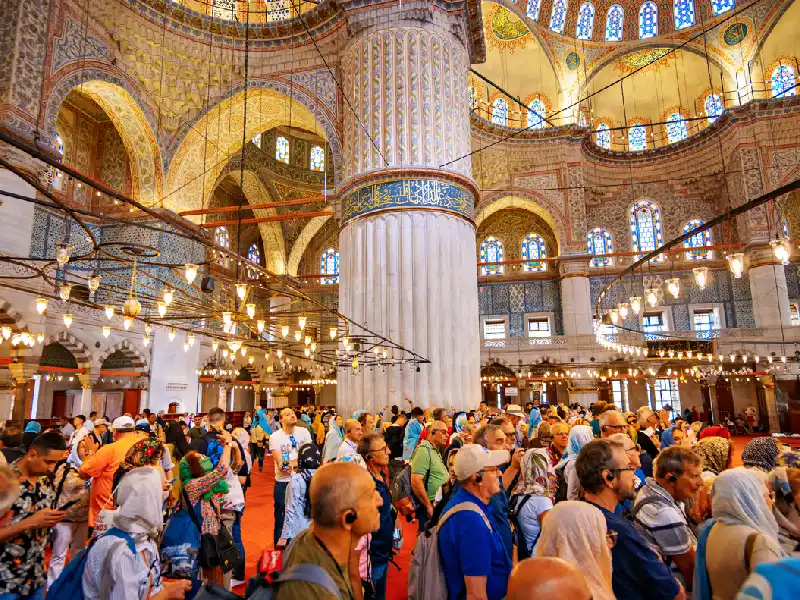
What you’ll see inside the Sultan Ahmed Mosque
The entrance of Sultan Ahmed Mosque reveals an inside that astonishes the visitors. Guests step into a world filled with artistic splendor and religious significance.
The large prayer hall and central dome
A breathtaking central dome towers 43 meters above individuals' heads. Four massive pillars hold the dome, fittingly called "elephant feet" for their enormity and shape. Semi-domes slope downwards surrounding the central dome and create a wavy ceiling effect in the prayer hall. The carpeted main praying space holds thousands of worshippers simultaneously, with visible praying lines marked for devotees.
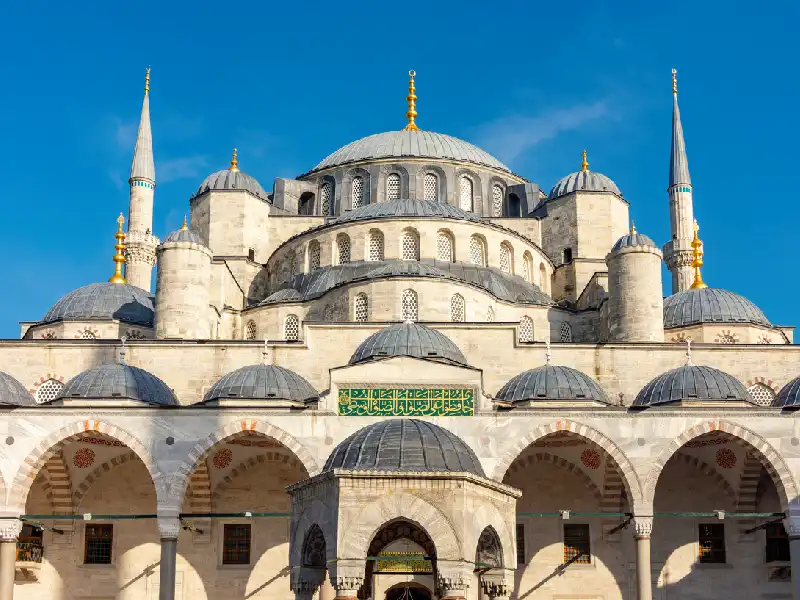
Blue Iznik tiles and stained glass windows
The mosque gets its popular name from stunning blue İznik tiles that adorn its interior walls. Thousands of handmade ceramic tiles - over 20,000 - depict dainty floral patterns in beautiful shades of turquoise and blue. These outstanding tiles rise half the height of the pillars and walls to create a dazzling visual effect.
More than 200 stained glass windows loom above them, pouring sunbeams in colors that dance within the interior. Islamic geometric patterns employed within the windows produce enchanted colored light that transforms the atmosphere of the mosque based on the position of the sun in the sky.
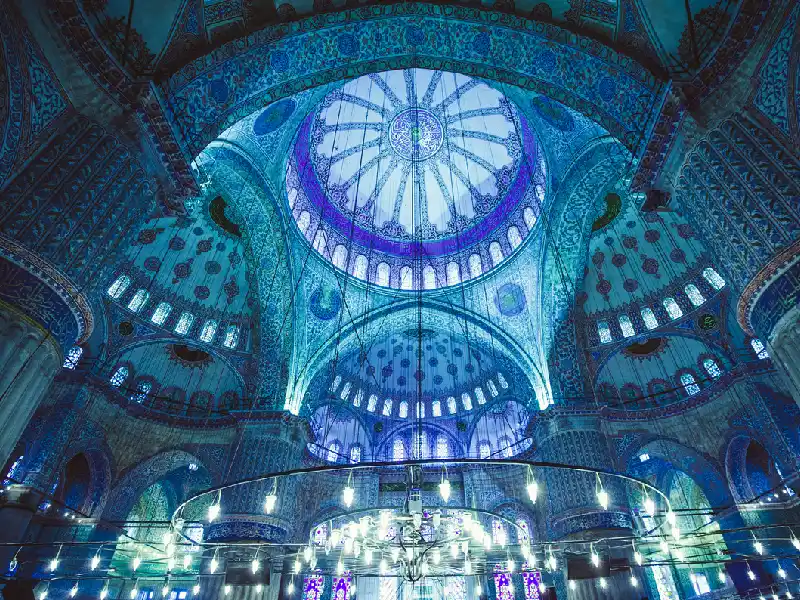
The ornate mihrab and minbar
The mihrab, an alcove of prayer that faces Mecca, is the most ornate feature of the mosque. The beautiful nook, which was carved from outstanding marble, guides the believers in prayer. The minbar stands nearby - a stepped pulpit where the imam delivers Friday sermons. Both structures reflect the finest 17th-century Ottoman craftsmanship in the finer stone carving.
The sultan's loge and imperial pavilion
The sultan's private lodge is found on the eastern wall, and it is a platform raised on which Ottoman rulers prayed in seclusion. The private prayer space has the imperial pavilion linked to it with its own mihrab boasting the mosque's most beautiful tilework. The royal division had an independent entrance previously that enabled the sultan to gain access directly from palace grounds.

Tips for the best visitor experience
A well-planned visit to the Blue Mosque of Istanbul will make your experience memorable. These practical tips will improve your time at this magnificent landmark.
Best times to visit to avoid crowds
The best time to explore is on weekday mornings between 9:00 AM and 11:30 AM. Tourist and worshiper numbers swell during weekends. You should skip Fridays completely since the mosque stays closed to non-worshippers until 2:30 PM due to weekly prayers. Visitors can enjoy milder weather and smaller crowds from April to May and September to October compared to the peak summer season.
Why early morning or late evening is ideal
The mosque offers a nice atmosphere and architectural splendor in the early morning. The morning light makes it perfect to appreciate the intricate details. The sunset creates a magical view that reshapes the mosque's appearance. These times help you avoid long security lines, which can take 30 minutes in low season and stretch up to an hour during peak times. The lighting conditions are also perfect for photos.
Bringing a bag for your shoes
The Sultan Ahmed Mosque requires all visitors to remove their shoes. The entrance provides plastic bags for your footwear. It's better to bring your own lightweight bag to avoid running into shortages during busy times. You can carry your shoes or leave them on the designated shoe racks.
Photography rules and respectful behavior
The Blue Mosque allows photography with these important guidelines:
- No flash photography is allowed
- Don't photograph worshippers at prayer
- Keep quiet and show respect
Your phone should be on silent mode. Speak softly to avoid disturbing people at prayer. Most visits take 30–45 minutes.
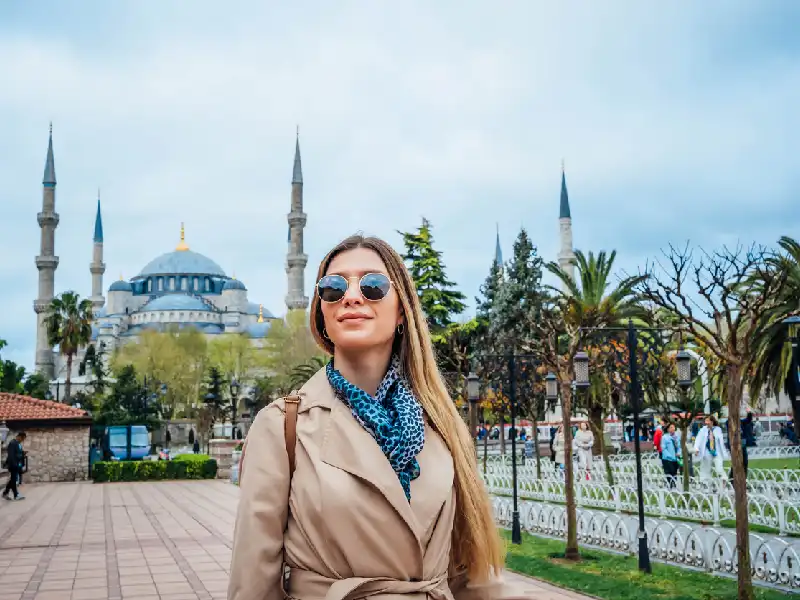
Exploring the area around the mosque
The Blue mosque stands in one of Istanbul's most historically rich districts. Visitors can discover amazing attractions right outside the mosque's grounds.
Hagia Sophia and the Hippodrome
The legendary Hagia Sophia stands next to the Blue Mosque. These architectural masterpieces are just a short walk apart in Sultanahmet Square. The Hippodrome, a grand Roman chariot-racing arena built in 203 AD, sits beside the Blue Mosque.
This massive rectangular arena held up to 100,000 spectators during the Byzantine era. The open square now features three ancient monuments that tell fascinating stories: the Obelisk of Theodosius from ancient Egypt, the Serpentine Column from Apollo's Temple, and the Walled Obelisk.
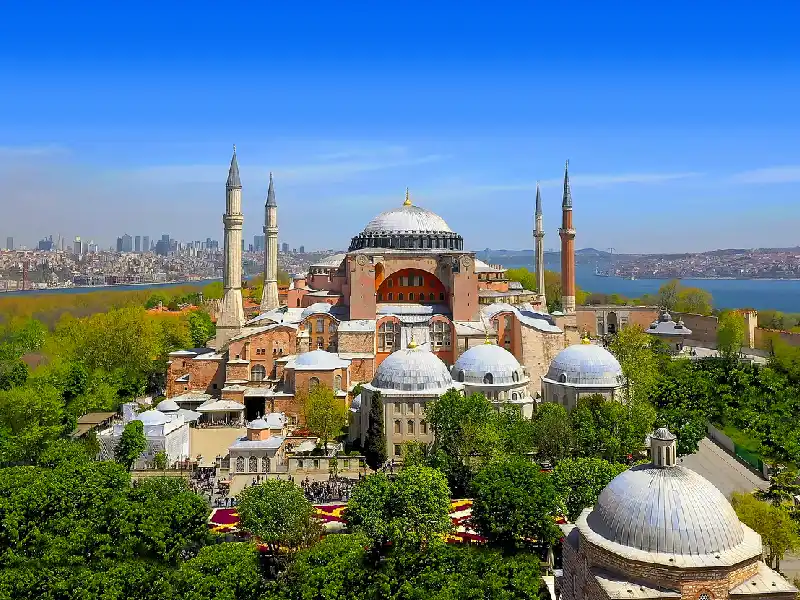
Arasta Bazaar and local shops
The historic Arasta Bazaar stretches behind the Blue Mosque as part of the mosque's külliye (complex). Built in the 17th century to support the mosque's upkeep, this beautiful marketplace houses 124 shops that showcase classical Ottoman style.
The bazaar provides a peaceful alternative to the busy Grand Bazaar and sells quality Turkish goods. Jennifer's Hamam sells traditional textiles, Troy Rug Store offers authentic carpets, and Flamingo Spices stocks premium saffron and spices. Shops welcome visitors daily from 9 AM to 7 PM.
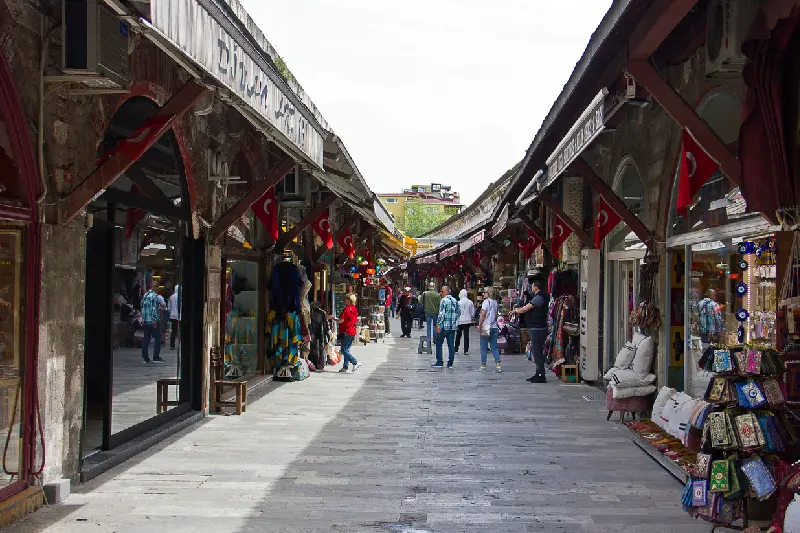
Nearby museums and cultural centers
The neighborhood features remarkable museums. The Turkish and Islamic Arts Museum displays beautiful Islamic artifacts like manuscript Qurans, carpets, ceramics, and metalwork. The Great Palace Mosaic Museum lies beneath Arasta Bazaar and houses stunning Byzantine mosaics from the 6th century.
The Istanbul Archeological Museums complex contains three distinct spaces: the Archeology Museum, the Museum of Ancient Oriental Art, and the Tiled Pavilion Museum. These museums give visitors a detailed look into Istanbul's cultural heritage.
Discover the Blue Mosque and the best of Turkey on our Turkey Tours and Middle East trips!
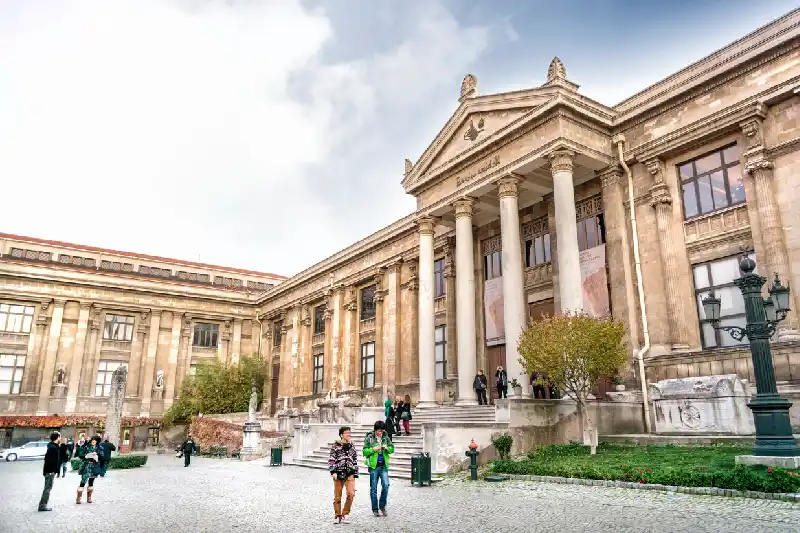
FAQS
Q1: Why is the Blue Mosque famous?
The Blue Mosque, also known as Sultan Ahmed Mosque, is renowned for its stunning blue İznik tiles, majestic domes, and six towering minarets. It’s one of Istanbul’s most iconic landmarks and a masterpiece of Ottoman architecture.
Q2: What to wear in the Blue Mosque?
Modest attire is required when visiting the Blue Mosque. Women should cover their heads, shoulders, and legs, while men should avoid wearing shorts. Scarves and wraps are usually available at the entrance if needed.
Q3: Is Blue Mosque free to enter?
Yes, entry to the Blue Mosque is free for all visitors. However, donations are appreciated to help with the upkeep, and respectful behavior is expected, especially during prayer times.
Q4: Are Hagia Sophia and Blue Mosque the same?
No, they are two different monuments located near each other in Istanbul. Hagia Sophia is a former church and mosque turned museum and now mosque again, while the Blue Mosque was built as a mosque and remains an active place of worship today.






